2020: My Year in Books
These are the masterpieces that got me through a year at home
By Evan Meade, 2021-01-02 08:17:03
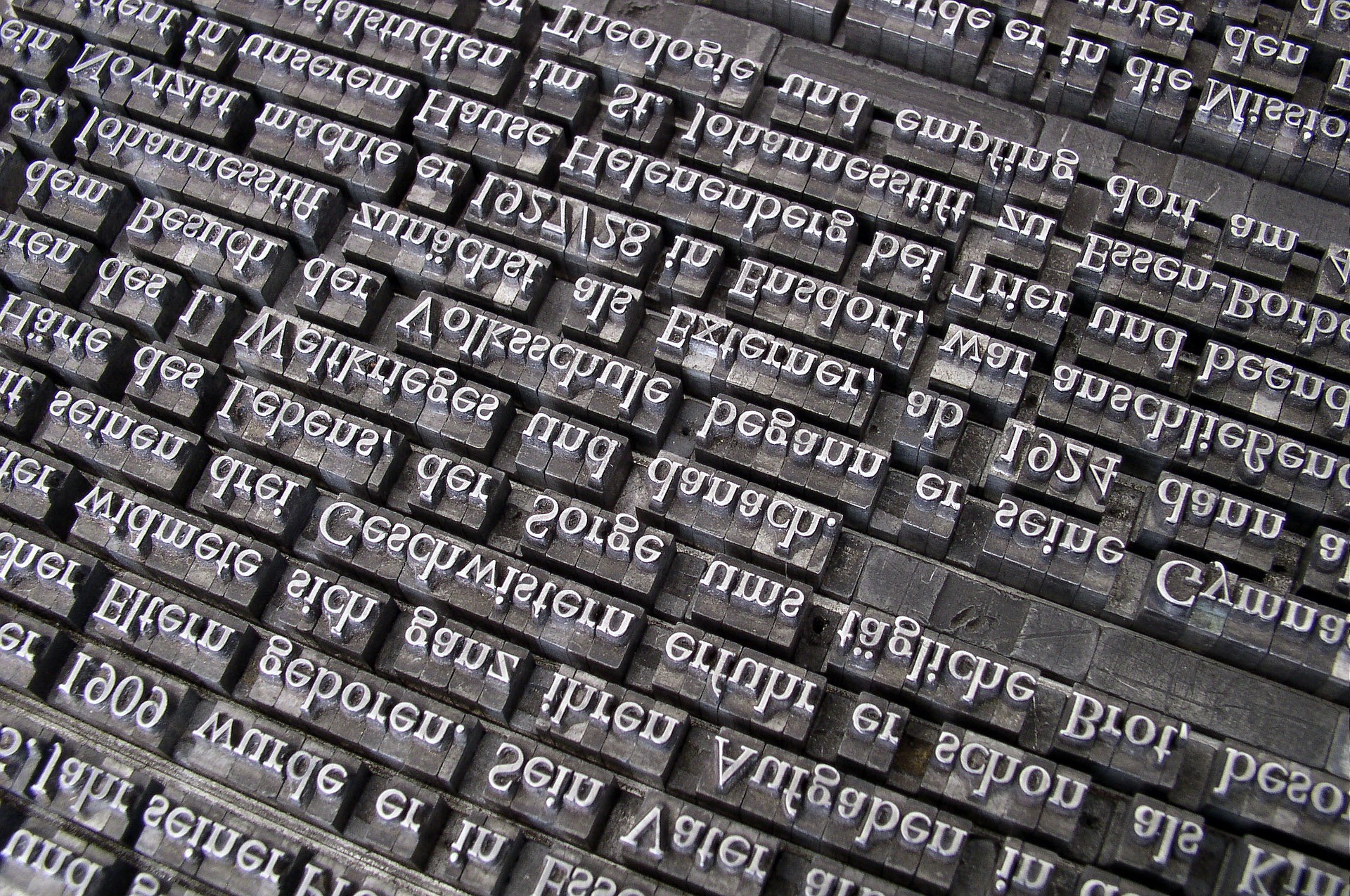
Like many a nerd, I spent a lot of time reading when I was young. No matter where I was, I always had a book within reach just in case I would find myself with a few spare minutes. Even without a background in child psychology, I am confident that my excessive reading did more to make me who I am than almost anything else in my life. It taught me patience, empathy, science, and creativity while providing me endless entertainment. And yet, like a lot of my well-read friends, it became a smaller and smaller part of my life as I grew older.
By the end of high school, it had gotten to the point that I could barely remember the last time I had actually completed a book by my own volition. Sure I was incredibly busy with homework and college applications and extracurriculars, but the real truth was that my attention span had been shattered by my smartphone.
I’ve written before about how Big Tech monetizes our attention through addictive, targeted content. My personal vice has always been YouTube, and though I can sometimes escape its inexorable pull for days or even weeks at a time, it still has as firm a grasp over me as ever. I’ve learned that in addition to simply weaning myself off of it, I have to replace online content with something else. In a desire to rebuild my attention span, that something has been reading.
In 2019, I started keeping track of every book I read using a combination of Google Keep and Goodreads. Rather than setting any particular goal for myself, I simply resolved to record books I had finished that year (any books I set aside for later are nice, but don’t earn credit). My approach was inspired by the principle that the mere observation of a phenomenon can be enough to change it, a fact reflected by both quantum mechanics and governmental oversight. I hoped that by simply becoming more aware of how much (or how little) I was reading, I would come to read more overall. Whether or not that was actually true in this case, the fact is that just two years later, I am reading more than I have since probably 5th or 6th grade.
This year, I read
26 books
!!! That’s a book every 2 weeks if you do some minor rounding! And yes, you bet I’m bragging about it. Though I still spend a lot of time on YouTube or other sites, it’s definitely less than before. So, as a celebration, I wanted to draw up some cool stats about my reading and hype up my favorite books of the year. Of course, if you’re just looking for reading recommendations, feel free to skip down to that section.
By the numbers
I compiled the data on the books I read from Keep and Goodreads into a .csv file, which I analyzed using R. All of my work is available in this public GitHub repository. Sadly, upon review, it was evident that the dates completed, as tracked by Goodreads, were highly inaccurate and incomplete. Likely a result of user error, it had not been properly recording the dates of my completion like I had assumed for most of the year. As a result, I now only know the order in which I read everything.
Titles and authors were recorded in my Keep list, and I pulled additional data from Goodreads including year of publication, page length, and genre. Genre was based on the top category listed according to user votes.
Right off the bat, here’s the basic statistical overview:
- 26 books read
- 8,703 pages read
- ~348 hours of reading (I read at ~25 pages/hour)
Overall, I’m pretty happy with those numbers. Averaging about an hour of reading a day and a book every 2 weeks is definitely better than I’ve been doing in years past. Hopefully I can get those figures even higher in 2021.
As far as visualizations go, let’s start off with a high level overview of my reading habits. Here, we can see the length and genre of the books, in the order that I read them. The mean book length was ~335 pages.
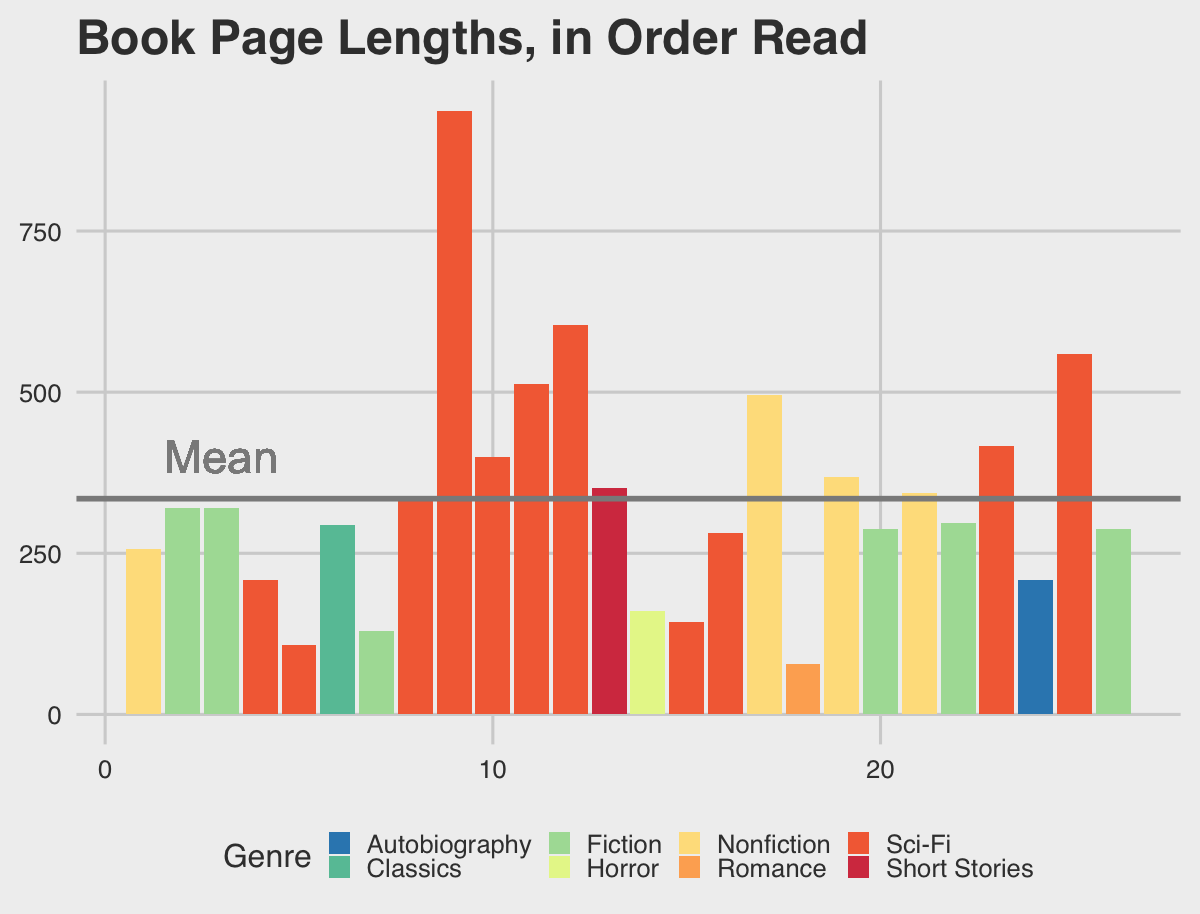
Bar plot of book lengths and genres, plotted in order read
By simple visual inspection, we can see that most of the books are between 250 and 400 pages long. There are a few low outliers below 200 pages, and a few high outliers above 500 pages. Additionally, my most common genres are sci-fi, fiction, and nonfiction. In particular, I had a streak of 5 long sci-fi books around the middle of the year.
The most obvious statistic to analyze here is the page length of each book. We can visualize this using a histogram of the books’ lengths.
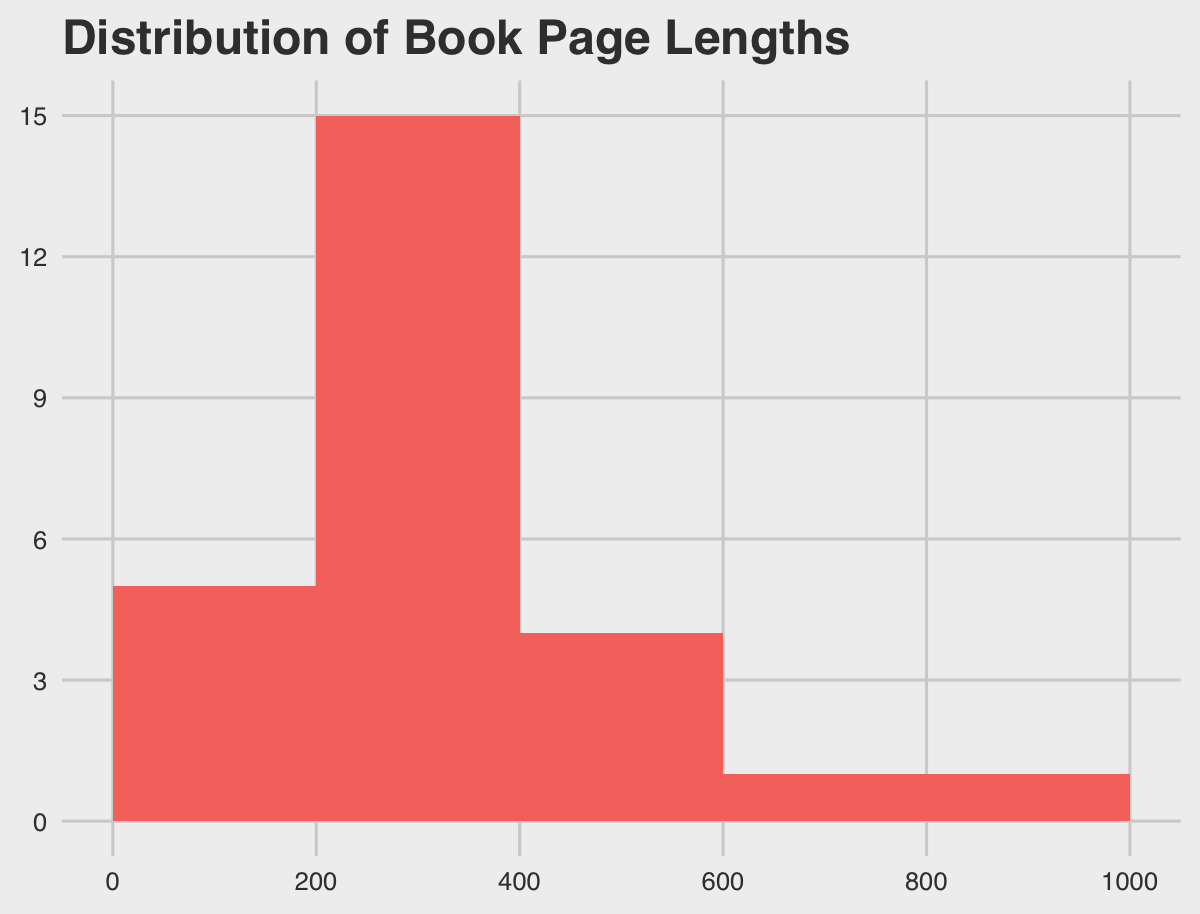
Histogram of the books' page lengths
The majority of the books I read were between 200 and 400 pages long, along with a tail of longer works. The longest, Anathem by Neal Stephenson, comes in at a whopping 937 pages. In the absence of a few outliers, however, this is a relatively symmetric distribution.
Next, let’s analyze the proportion of these books belonging to each genre. We can weight either by number of books, or by number of pages. The former is biased towards shorter works, while the latter is biased towards longer ones.
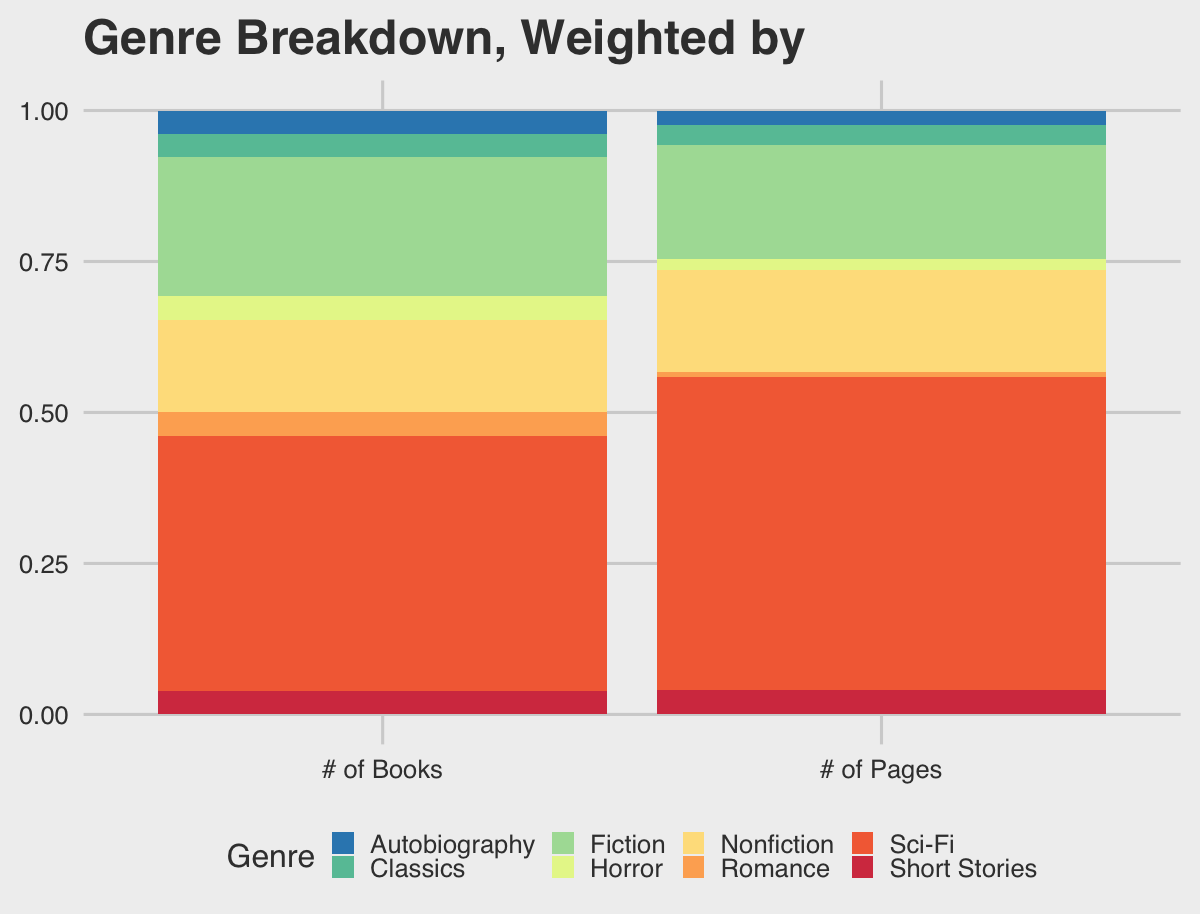
Stacked bar plots of genres, weighted alternately by books and pages
This plot clearly supports our observations from the previous section. These books belong almost entirely to either sci-fi, fiction, or nonfiction, with a scattering of 5 other genres. Even within that, sci-fi is clearly the largest component, accounting for ~52% of all my reading when weighting by page length.
It is interesting to note that the proportions are relatively similar in both weighting scenarios. The only genre which seems larger when weighting by pages is sci-fi, suggesting that these books happen to be longer on average than other genres. Indeed, they have an average length of ~410 pages, significantly more than the overall mean of ~335 pages.
In addition to length and genre, we can investigate the publication years of these books. The histogram of these years is plotted below, binned by decade.
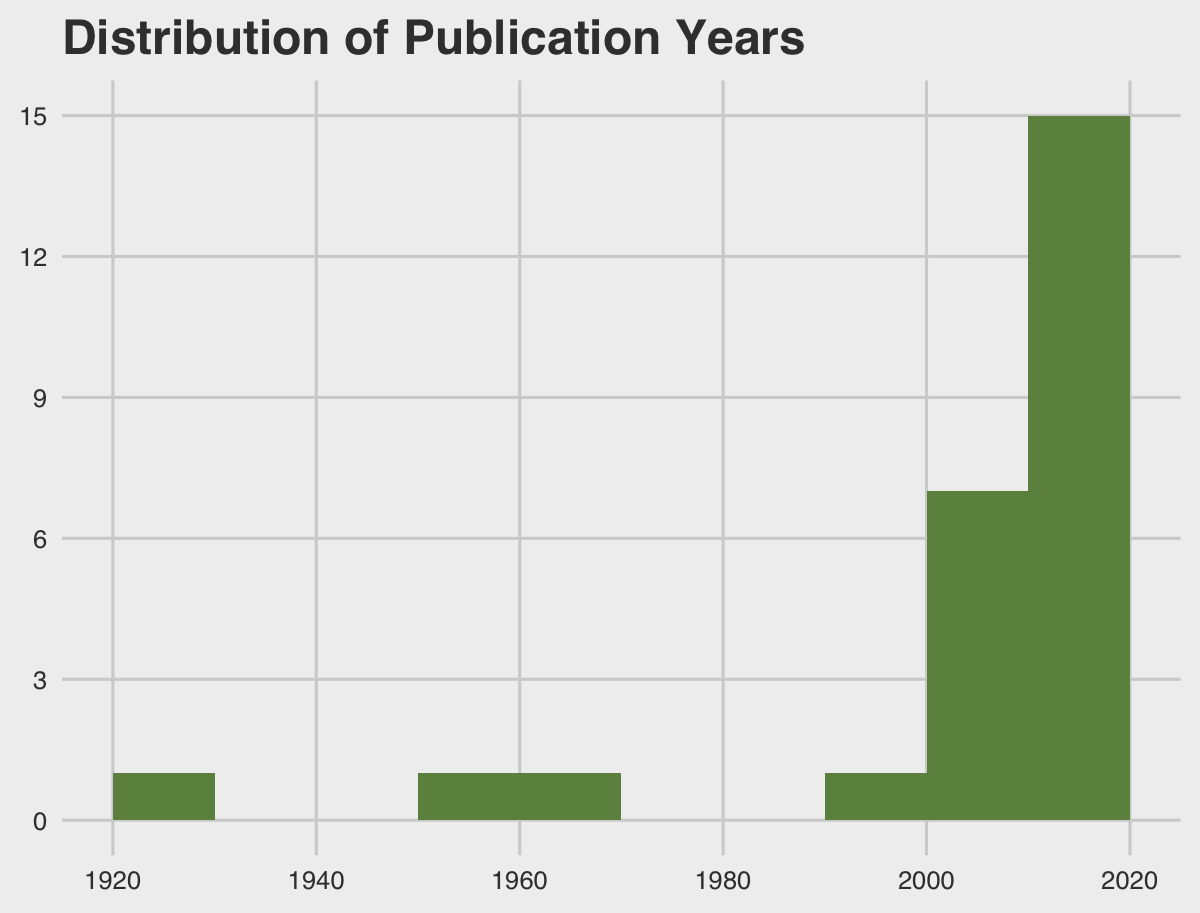
Histogram of the books' years of publication
It is obvious that most of the books are relatively modern. In fact, over half of them were published in the last decade. That being said, still ~15% of them are from before the turn of the millennium. The oldest, Death Comes for the Archbishop by Willa Cather, was first published all the way back in 1927.
Finally, we consider the authors of these works. The books can be grouped together by author, an act which shows us that only 5 authors account for over half of all the pages I read this year. We can visualize the number of pages belonging to each author below.
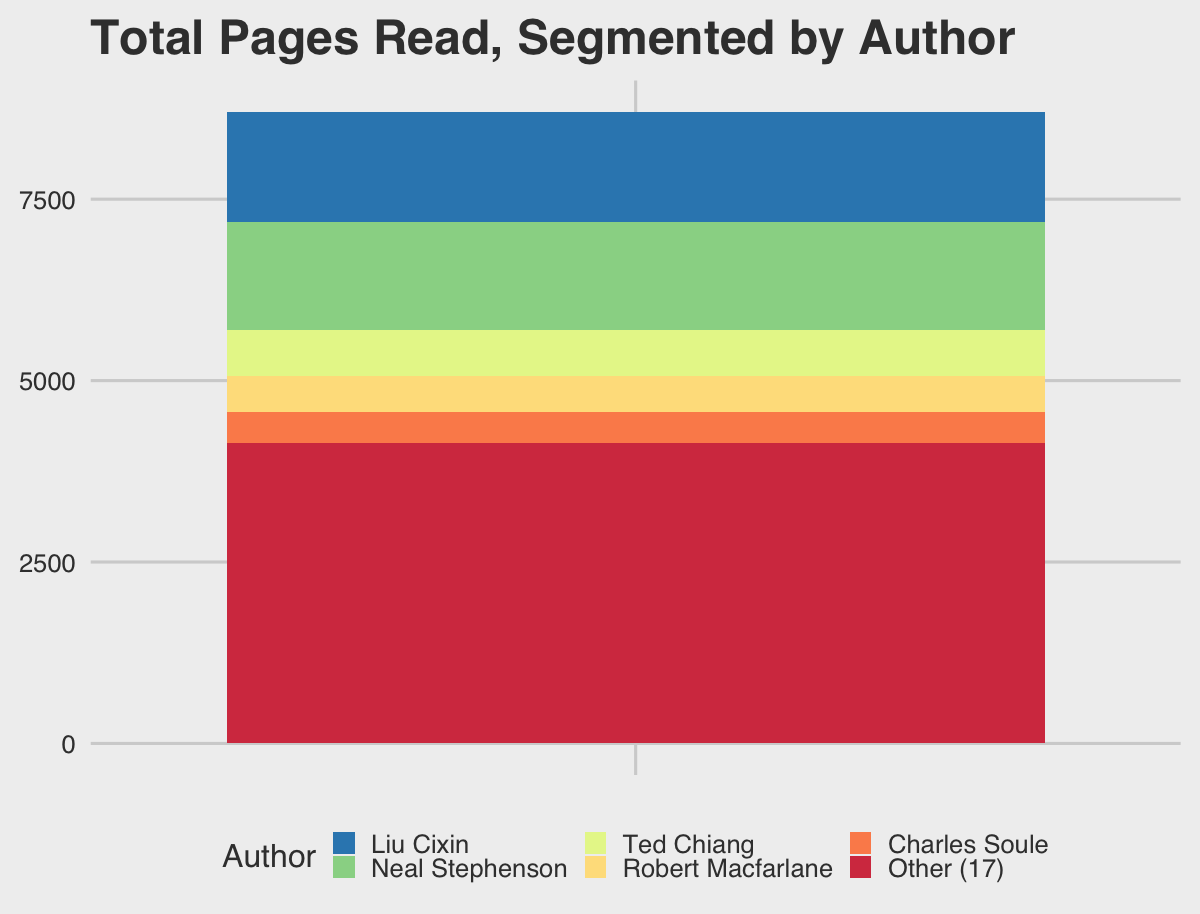
Stacked bar plot of pages read from each of the top 5 authors
The top 2 authors—Liu Cixin and Neal Stephenson—each account for ~1,500 pages, or ~17% of the total. Each of Ted Chiang, Robert Macfarlane, and Charles Soule account for ~500 pages, or ~6% of the total. So, despite reading from such a wide variety of books and genres, I was mostly reading the words of just a handful of authors.
So in conclusion, while I read a lot of different things this year, they were mostly long works of sci-fi written by a handful of authors. Because of this, I’m definitely trying to broaden my horizons with different kinds of books, as reflected by the colorful variety in the right half of the first plot.
My favorite reads of the year
NOTE: All book covers depicted here belong to their respective copyright owners
I read a lot of great books this year (along with a few disappointing ones). However, a few stood out among the rest. Since no article would be complete without a clickbait list, here’s my top 5 books I read in 2020:
5. Anathem, Neal Stephenson
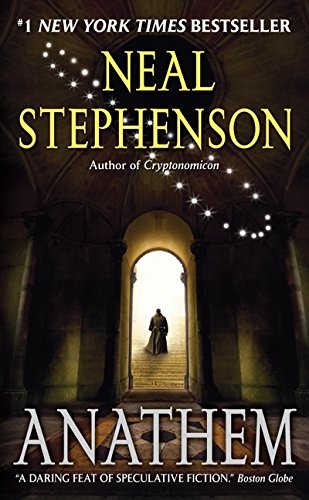
It is hard enough to construct a world as vast and coherent as Anathem’s in a single volume. It is even harder to tell the story of that world with anything more than the zeal of a history textbook. And yet, somehow, Neal Stephenson manages to relate this extraordinary world as a compellingly human epic.
This is a TOME of a book (~1,000 pages) telling the story of an alternate world where scholars are feared and forced to live in ascetic, monastic conditions until called upon in times of great need. It is a sprawling narrative, weaving together histories, philosophies, politics, and sciences both real and imagined. The result is a wonderfully layered experience that sucks you in deeper the more you read.
Highly recommended to those who have wondered what it would be like to have a nation of nerds.
4. The Midnight Library, Matt Haig
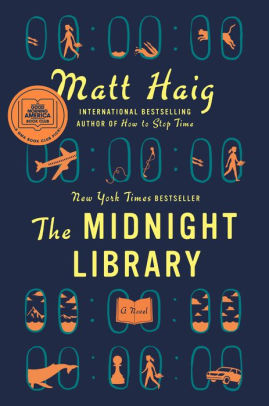
This was the last book I read this year, but possibly one of the most memorable. The caption on the back really says it all:
"Between life and death there is a library, and within that library, the shelves go on forever. Every book provides a chance to try another life you could have lived. To see how things would be if you had made other choices . . . Would you have done anything different, if you had the chance to undo your regrets?"
Touching, personal, and infinitely relatable, Matt Haig’s writing connects with our deepest insecurities about the lives we lead. What could we have done better in our lives? What makes us happy? Is happiness even the point of life? No matter where you’re at in life or what you do, I genuinely think everyone has something to gain from this gem of modern magical realism.
In a year defined by challenges and seeming powerlessness, this read conveys a refreshing sense of agency and possibility.
3. Snow Crash, Neal Stephenson
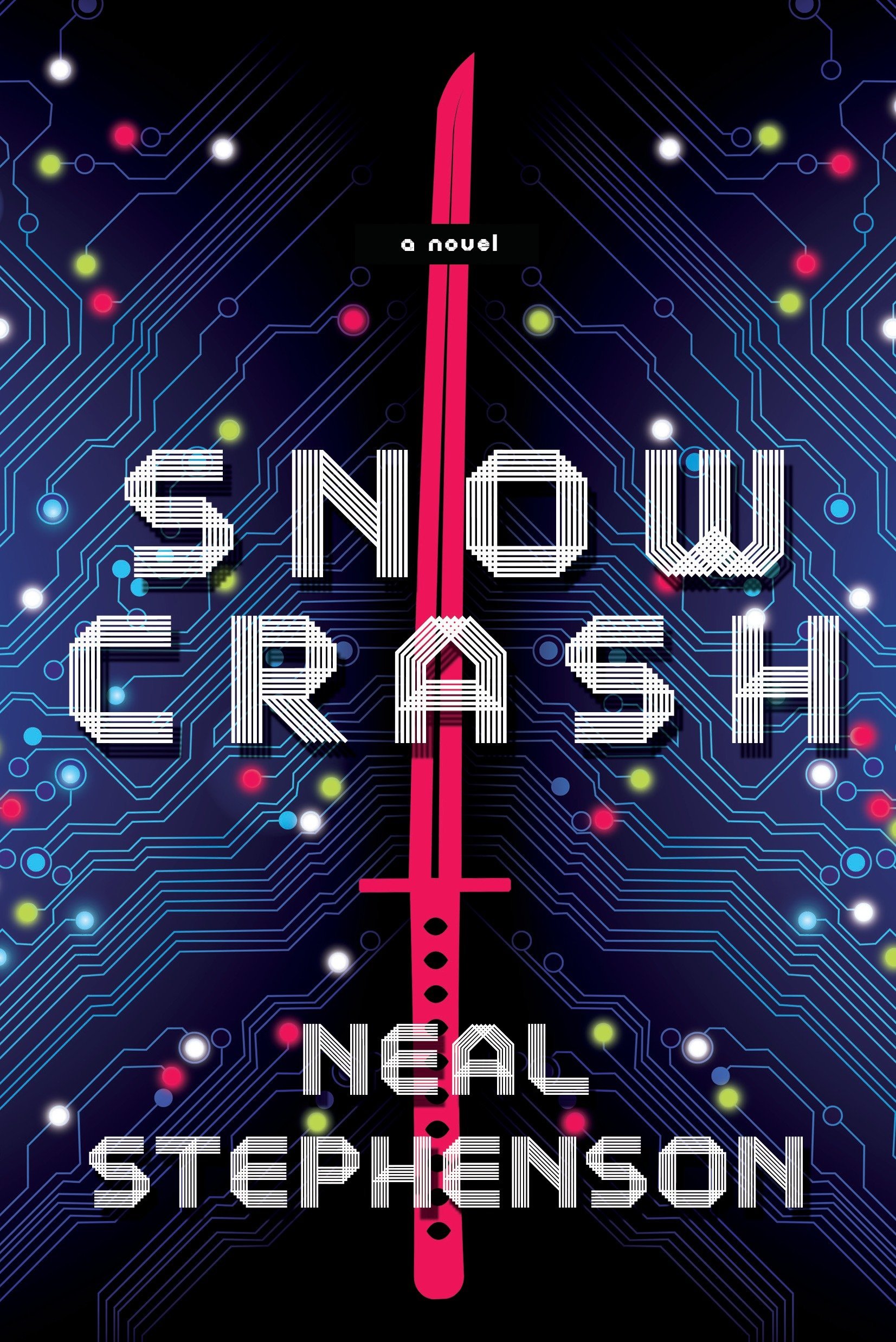
Much like Anathem, this is another masterclass in worldbuilding sprung from the mind of Neal Stephenson. A classic of cyberpunk literature from the dawn of the internet back in 1992, this thick novel describes a colorful, hyper-capitalist America with impressive(ly concerning) prescience.
The United States as we know it has been fractured into a mosaic of city-state franchises, empowered by technology. Our hero, wryly named Hiro Protagonist, is one of the last freelance hackers in this increasingly corporate world, forced to deliver pizza just to eke out a meagre existence. However, in a remarkable virtual reality world known as the Metaverse, he’s a legendary sword fighter. When confronted with a pressing challenge, he must rely on his skills and independent thinking in order to uncover the mystery of a deadly new virus known as “Snow Crash”.
A fast-paced and engaging story from the very start, Hiro’s journey is thrilling, hilarious, and, at times, distressingly familiar.
2. The Three Body Problem, Liu Cixin
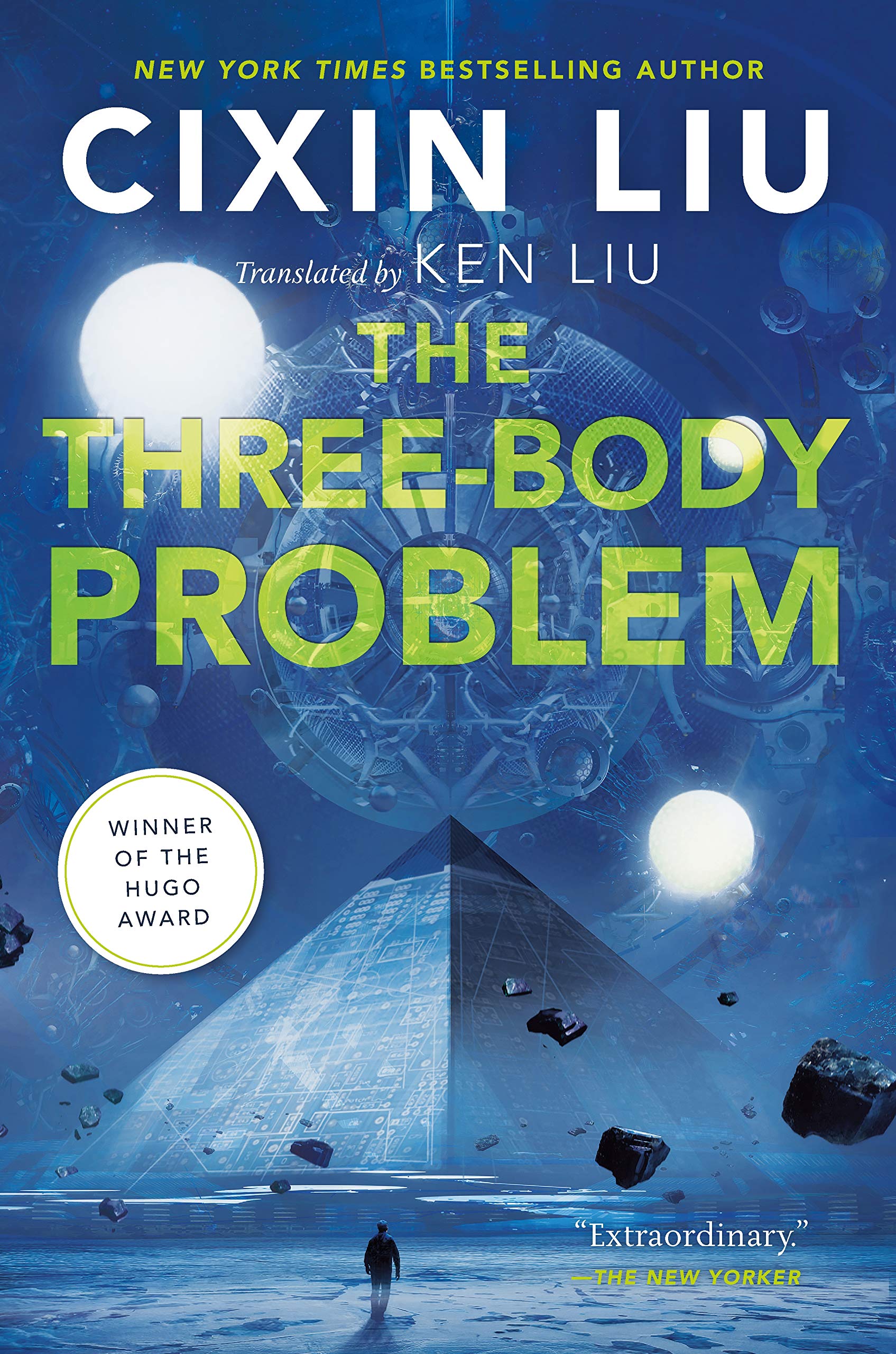
One of the first works of Chinese sci-fi to receive widespread Western acclaim, this is the beginning of a brilliant trilogy about aliens and our place in the universe. I really don’t want to say that much about the plot for fear of spoiling its twists and turns, but I simply cannot recommend it highly enough.
Liu Cixin’s magnum opus is an intoxicating blend of ruggedly hard sci-fi and imaginative space opera. The characters are brilliant, the plot thrilling, and the world ever changing. It is hard to imagine a more cleverly constructed tale of humanity’s first contact with the stars.
Anyone who considers themselves a fan of modern sci-fi is truly obligated to devour this book, and hopefully the rest of the series as well.
1. Underland, Robert Macfarlane
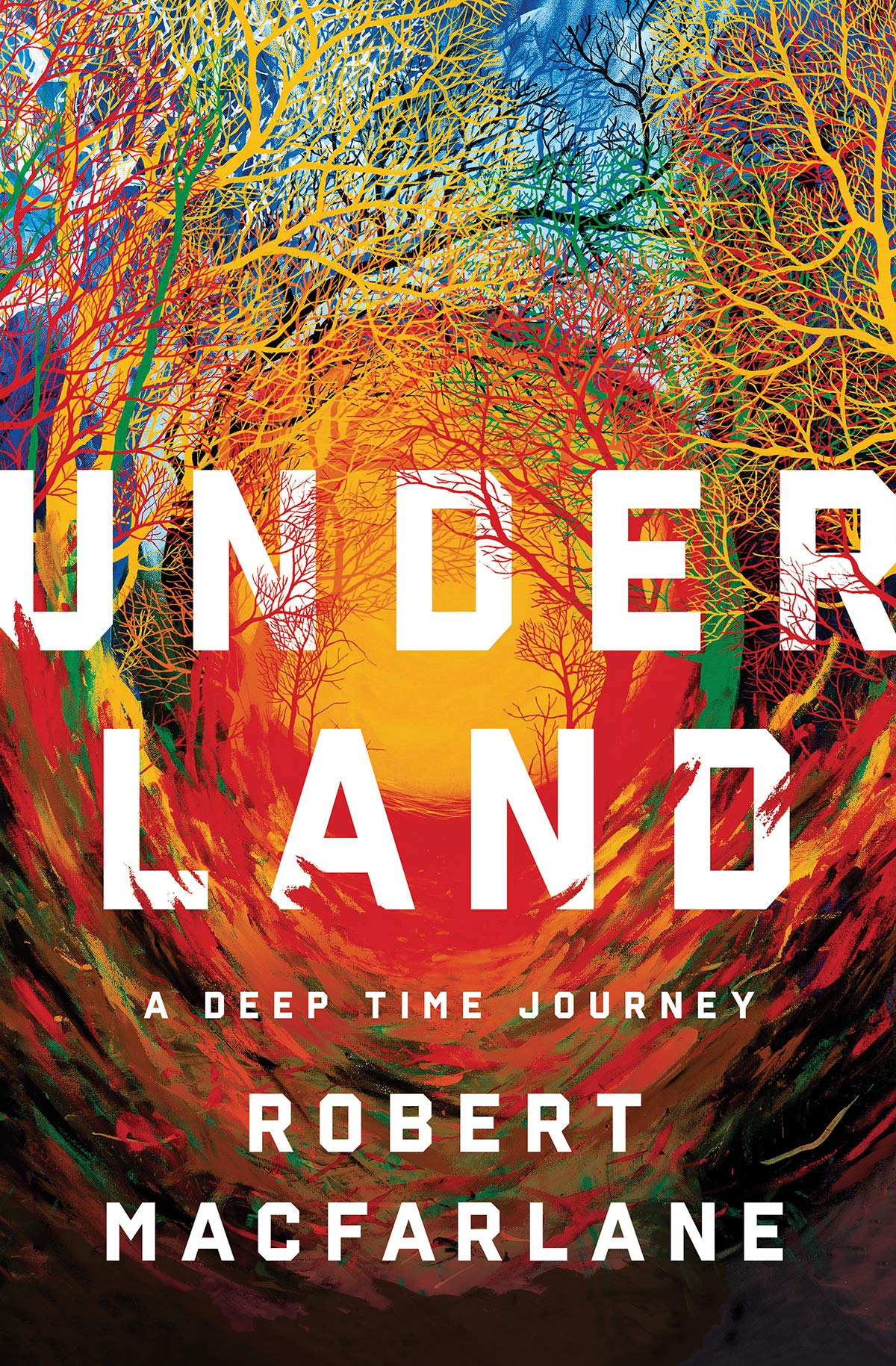
While I find it hard to decide whether or not I’d like to follow Robert Macfarlane in his claustrophobic journeys, I sure as hell enjoyed reading about them. This masterpiece is a portrait of Earth taken in geologic time. It is an account of Macfarlane’s actual adventures exploring those parts of our world which hide below the surface.
His quest to understand the Underland takes him to Yugoslavian bunkers, the catacombs of Paris, Poe’s Scandanavian Maelstrom, and beyond. With astounding imagery and revealing history, these retellings bring us closer than ever to a sense of connection with “deep time” and the timescales of our planet.
At once inert and intensely human, this is some of the finest environmental literature of our time, and essential to those seeking a deeper connection to this pale blue dot.
Honorable Mentions
Sandworm, Andy Greenberg - For those of you who suffer from sleep which is simply too secure and restful, I sincerely recommend almost any chapter in this book. Written by one of WIRED’s senior writers, Andy Greenberg, this work of well-researched nonfiction reads like the plot of a movie. Tracing the activities of a secretive Russian hacking group known as “Sandworm”, this reportage outlines the existential threats of cyberwarfare as they relate to critical infrastructure. Executive summary: the computers at power plants are really, really important.
The Oracle Year, Charles Soule - What would you do with 108 very specific predictions about the next 3 years? This clever thriller from Charles Soule attempts to answer that question from the perspective of a lucky, though remarkably ordinary man. Drawing upon a cast of brilliant, well-resourced characters, this story is a wildly entertaining thought experiment that you just can’t set aside.
Data Science
Books ggplot2 R